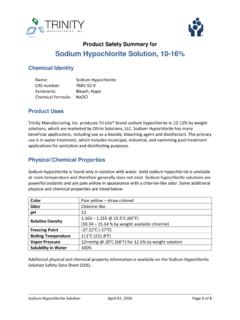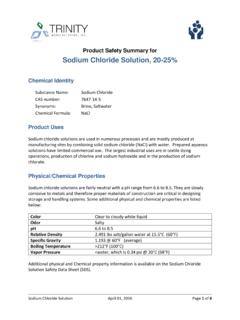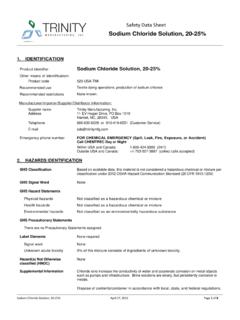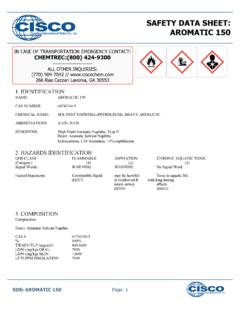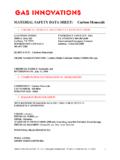Transcription of SAFETY DATA SHEET - trinitymfg.com
1 Hydrochloric Acid 32-36% Page 1 of 14 06-01-2015 SAFETY DATA SHEET 1. Identification Product Identifier Hydrochloric Acid, 32-36% Other Means of Identification: Product Code 507-USA-TMI Recommended Use Metal processing, pH adjustment for water treatment Synonyms Muriatic Acid, 20-22 Degrees Baum Muriatic Acid, Aqueous Hydrogen Chloride Manufacturer/Importer/Supplier/Distribut or information: Supplier name Trinity Manufacturing, Inc. Address 11 EV Hogan Drive, PO Box 1519 Hamlet, NC, 28345, USA Telephone 800-632-6228 (Customer Service) E-mail Emergency phone number FOR CHEMICAL EMERGENCY (Spill, Leak, Fire, Exposure, or Accident) Call CHEMTREC Day or Night Within USA and Canada: 1-800-424-9300 Outside USA and Canada: +1-703-527-3887 (collect calls accepted) 2. Hazard(s) Identification Physical Hazards Corrosive to Metals Category 1 Health Hazards Acute Toxicity, inhalation Category 1 Acute Toxicity, oral Category 1 Serious Eye Damage Category 1 Skin Corrosion Category 1 Respiratory Sensitization Category 1 Environmental Hazards Not classified OSHA Defined Hazards Not classified Label Elements Signal Word DANGER Hazard Statements Fatal if inhaled (mist, vapor).
2 Fatal if swallowed. Causes serious eye damage. Causes severe burns and eye damage. May cause allergic or asthmatic symptoms or breathing difficulties if inhaled. May be fatal if swallowed and enters airway. May be corrosive to metals. Hydrochloric Acid 32-36% Page 2 of 14 06-01-2015 Prevention Do not breathe mist/vapors. Avoid skin contact. Keep container tightly closed. Wear respiratory protection, protective gloves, and eye/face protection. Use only in well-ventilated area. Store container tightly closed in cool/well-ventilated area. Wash thoroughly after handling. 3. Composition/Information on Ingredients Chemical Name Common Name and Synonyms CAS Number % by Weight Hydrogen Chloride Muriatic Acid 7647-01-0 32-36 Water 7732-18-5 Balance 4. First Aid Measures General Information Corrosive effects on the skin and eyes may be delayed, and damage may occur without the sensation or onset of pain.
3 Strict adherence to first aid measures is essential. Eye Contact Rinse immediately with plenty of water for at least 20 minutes holding eyelids apart. Remove any contact lenses. Get medical attention immediately. Skin Contact Immediately flush skin with plenty of water for at least 20 minutes while removing contaminated clothing and shoes. If skin is only irritated and symptoms do not persist, wash with a disinfectant soap. If skin is burned, get medical attention immediately. During transport apply compresses of cold water, if available. Wash clothing separately before reuse. Discard heavily contaminated shoes or clothing. Inhalation Move to fresh air. If breathing is difficult, give oxygen, if available. If not breathing, give artificial respiration. A one-way pocket mask will prevent cross-contamination to the provider. Get medical attention immediately.
4 Symptoms may appear up to 48 hours after exposure. Ingestion Do NOT induce vomiting. Immediately give large quantities of water or milk, if available. If vomiting does occur, give fluids again. Never give anything by mouth to an unconscious person. Call a physician or the nearest Poison Control Center. Notes to Physician Treat symptomatically and supportively focusing on the respiratory and cardiovascular functions. No specific antidote exists. Symptoms of pulmonary edema, such as shortness of breath, can be delayed for several hours after exposure. 5. Fire-Fighting Measures Flammability Not flammable , but reacts with most metals to form flammable Hydrogen gas. Flash Point Not applicable flammable /Explosive Range Not applicable Auto- ignition Temperature Not applicable Sensitivity to Mechanical Impact Not sensitive Sensitivity to Static Discharge Not sensitive Decomposition Temperature This product will not decompose at temperatures below 1500 C (2730 F).
5 Suitable Extinguishing Media Substance is non- flammable so extinguishant should be appropriate for acid and the burning material. For large fires, an all-purpose AFFF foam may be used. For small fires, use dry chemical or carbon dioxide. If only water is available, use it in the form of a fog. Water fog is also effective for controlling vapors. Unsuitable Extinguishing Media Do not use carbon dioxide if cyanides are involved in a fire. Do NOT use straight streams of water. Hydrochloric Acid 32-36% Page 3 of 14 06-01-2015 Protection of Firefighters Specific Hazards Arising This product is corrosive, and presents a significant inhalation and contact hazard to fire- From the Chemical fighters. Irritating and toxic gases or fumes may be released during a fire. Protective Equipment and As in any fire, wear self-contained breathing apparatus pressure-demand, NIOSH- Precautions for Firefighters approved or equivalent, and full protective gear apparatus.
6 Fire Fighting Equipment/ Move containers from fire area if you can do so without risk. Use water spray to keep fire- Instructions exposed containers cool. If possible, prevent run-off water from entering storm drains, bodies of water, or other environmentally sensitive areas. Fire and Explosion Hazards Reacts with active metals (potassium, sodium, calcium, powdered aluminum, zinc, magnesium) to liberate flammable hydrogen gas which can form explosive mixtures. Explosive concentrations of hydrogen may accumulate inside metal equipment. Combustion and Thermal Hydrogen chloride, chorine, and hydrogen gas. Decomposition Products Evacuation If tank, rail car, or cargo trailer is involved in a fire, isolate for mile in all directions and consider initial evacuation for mile in all directions. 6. Accidental Release Measures Personal Precautions Keep unnecessary personnel away until cleanup has been completed.
7 Ensure adequate ventilation. Wear adequate personal protective equipment (PPE). (Section 8 Exposure Controls for Specific PPE information). Do not touch spilled material. Environmental Precautions All spills on land involving hydrochloric acid should be contained, if possible, to prevent entry into bodies of water or sewer systems and into low lying areas like basements. Methods for Containment ELIMINATE all ignition sources (no smoking, flares, sparks or flames in immediate area). Stop leak if this can be done without risk. Dike the spilled material, where this is possible, using sand, dirt, or similar material. Methods for Cleaning Up Small Spills Cover with an inert dry material (earth, sand, or other non-combustible material). Use non-sparking tools to collect material and place in a loosely covered plastic container for later disposal. Do not get water inside container.
8 Large Spills As an immediate precautionary measure, isolate spill or leak area in all directions for at least 50 meters (165 feet). Build dikes far ahead of the spill to contain the liquid for later reclamation or disposal using inert material such as sand, earth, foamed polyurethane, or foamed concrete. Absorb the bulk of the liquid with fly ash or cement powder. Neutralize with recommended materials, taking care to avoid any foaming or splattering that may occur from the neutralizing reaction. Make sure all liquid has been thoroughly contacted and absorbed by the dry materials. Transfer absorbed spill material and contaminated soil to a suitable chemical waste container. Ensure adequate decontamination of tools and equipment following clean up. Washing down of spills with water is not recommended as this tends to spread the contamination and increases the likelihood of percolating the acid down through the soil and/or of uncontrolled flow of acid into sewers, streams, or other waters.
9 Do not allow spill material to contact any acid soluble sulfide wastes (such as in sewers) because of the danger of evolving hydrogen sulfide gas. Do not put water directly on leak or spill area. Use water spray curtain to divert vapor drift that is beyond spill area. Call for assistance on disposal. Deactivating Chemicals Lime, limestone, sodium carbonate (soda ash), sodium bicarbonate. Absorbent materials which have been tested and recommended for concentrated hydrochloric acid are anionic polyacrylamide, nonionic polyacrylamide, and hydroxyethylcellulose. Waste Disposal See Section 13 Disposal Considerations. 7. Handling and Storage Handling Take precautions to avoid personal contact. Prevent release of vapor or mist. Ensure adequate ventilation in handling areas. Ensure water drenching facilities are close to the handling area. Inspect containers for leaks before handling.
10 Do not allow smoking or food consumption while handling or in storage areas. Wash well after use. Hydrochloric Acid 32-36% Page 4 of 14 06-01-2015 Never add water to this product. When diluting with water, always add acid to water and add it slowly. Avoid mixing with alkalis. Keep away from incompatibles such as oxidizing agents, organic materials, metals, alkalis, moisture. May corrode metallic surfaces. Do not wash down the drain. Storage Keep container tightly closed when not in use. Keep away from heat and flame. Do not store in direct sunlight. Store in a cool, dry, well-ventilated area away from incompatible substances such as hydroxides, amines, alkalis, or metals, such as copper, brass, zinc, potassium, and sodium. Restrict access to storage areas. Hydrogen, a highly flammable gas, can accumulate to explosive concentrations inside metal containers in storage.
